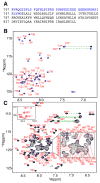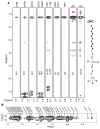Solution Structure and Membrane Interaction of the Cytoplasmic Tail of HIV-1 gp41 Protein
- PMID: 29056482
- PMCID: PMC5687296
- DOI: 10.1016/j.str.2017.09.010
Solution Structure and Membrane Interaction of the Cytoplasmic Tail of HIV-1 gp41 Protein
Abstract
The cytoplasmic tail of gp41 (gp41CT) remains the last HIV-1 domain with an unknown structure. It plays important roles in HIV-1 replication such as mediating envelope (Env) intracellular trafficking and incorporation into assembling virions, mechanisms of which are poorly understood. Here, we present the solution structure of gp41CT in a micellar environment and characterize its interaction with the membrane. We show that the N-terminal 45 residues are unstructured and not associated with the membrane. However, the C-terminal 105 residues form three membrane-bound amphipathic α helices with distinctive structural features such as variable degree of membrane penetration, hydrophobic and basic surfaces, clusters of aromatic residues, and a network of cation-π interactions. This work fills a major gap by providing the structure of the last segment of HIV-1 Env, which will provide insights into the mechanisms of Gag-mediated Env incorporation as well as the overall Env mobility and conformation on the virion surface.
Keywords: Gag polyprotein; HIV-1; NMR; bicelles; cytoplasmic tail; envelope protein; gp41; matrix protein; membrane; micelles.
Copyright © 2017 Elsevier Ltd. All rights reserved.
Figures





References
-
- Anraku K, Fukuda R, Takamune N, Misumi S, Okamoto Y, Otsuka M, Fujita M. Highly sensitive analysis of the interaction between HIV-1 Gag and phosphoinositide derivatives based on surface plasmon resonance. Biochemistry. 2010;49:5109–5116. - PubMed
-
- Batonick M, Favre M, Boge M, Spearman P, Höning S, Thali M. Interaction of HIV-1 Gag with the clathrin-associated adaptor AP-2. Virology. 2005;342:190–200. - PubMed
MeSH terms
Substances
Grants and funding
LinkOut - more resources
Full Text Sources
Other Literature Sources
Research Materials
Miscellaneous

